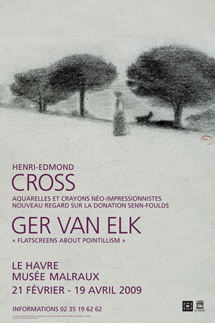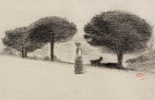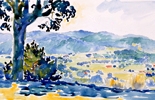Cross. Aquarelles et crayons neo-impressionnistes
from February 21 to April 26, 2009

Henri-Edmond Cross (1856–1910) made acquaintance with Seurat and Signac in 1884 at the Salon des Artistes Indépendants. The year of Seurat's untimely death (1891), he exhibited his first Divisionist painting, and thus marked his alliance with the Neo-Impressionists.
Like the other members of the group, he gave special attention to drawing. Quick and light, watercolour freed him from the strict rules of pointillist painting. In a letter to the painter Angrand, Cross wrote: "I am resting from my canvasses by trying watercolour and sketching with this medium. It is fun. The absolute need to be fast, bold, even insolent, throws a kind of beneficial fever into the work..." Living near Saint-Tropez, like Signac, Cross found this technique to be the most appreciable means of rendering the limpidity of the Mediterranean light and landscapes.
He executed a number of watercolours; some simple depictions of nature, others more studied and viewed as artworks in their own right. Cross was also a talented draftsman. While some of his drawings are preparatory studies for paintings, at times employing the grid method, others stand as full-fledged artworks.
The exhibition reunites the 2 paintings, 28 pencil and charcoal drawings, 9 watercolours and a pastel from the Senn-Foulds donation, along with over a dozen other watercolours from public and private collections. Three exceptional paintings teamed with their preparatory drawings are also on display.
In conjunction with and as a reflection of the Henri-Edmond Cross exhibition, the museum presents a series of eight videographic works by contemporary Dutch artist Ger van Elk, who began exploring pointillism in 2004 as part of his critical reflections on art history. Drawing inspiration from the work of Signac, Seurat and Cross, the artist reinterprets their painting in his "Flatscreens". The emblematic piece Snow over Seurat entered the museum's collection following the second contemporary art biennial in Le Havre, through the generous support of Groupe Partouche. Video pixels replace the Neo-Impressionist dots within these framed surfaces. The animated motif changes and pixellizes, depicting images of snow or birds until they grow abstract and disappear.



